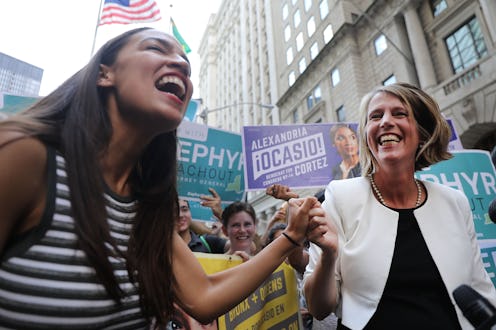News
These Stats On Women Running For Office In 2018 Will Get You Fired Up

Sometimes political trends are fuzzy and difficult to notice or interpret — and sometimes they're entirely clear. One of the defining trends of 2018's upcoming elections falls into the latter category: more women are running for public office than ever before, and so far, it looks like their efforts might be working. If you look through the stats about women running for office in 2018, there's lots of cause for optimism.
Studies so far have noted that more women running for office won't necessarily translate to more women winning their races: for example, 37 women running for the House as Democrats won primaries in districts that are "solid Republican" — meaning that they will be unlikely to win in the general election in November, CNN reported. Even that, though, isn't reason to lose heart — after all, Democratic candidates have put up some impressive showings in several recent races that would have been a sure thing for the GOP in the past.
In short, the midterms are almost certain to offer many surprises — but based on the current field, it wouldn't be too surprising if 2018 launched the most women into elected office that the country has ever seen.
1Women Are Running In Record Numbers
According to The New York Times, 476 women ran in Democratic or Republican primaries for Congress across the country. Some of those women have already lost their primary election — but there are still 323 races in which at least one woman is running.
2219 Women Have Won Congressional Primaries So Far
Bloomberg is keeping an updated tracker on women running in the 2018 midterms, and as of mid-August, 219 women have won their primary in either a House or a Senate race. 221 have lost, and there are another 83 whose races are still pending.
3Female Candidates Are More Experienced Than Male Candidates
According to a study carried out by FiveThirtyEight, ABC News, and Ballotpedia, women running for elected office in 2018 have more experience in government than their male opponents. This was especially true in races for higher offices, like the Senate or a governorship. For example, 56 percent of women running for governor across all of the states have previously held elected office, whereas only 37 percent of men running for governor have. When you're talking about Senate races, 80 percent of women candidates have previous experience in government, but only 22 percent of men do.
413 Women Will Be Running For Governor
There have never been more than nine female governors at any given time — but this year, there's a chance that 13 women could become the top executives of their respective states, according to PBS. Before the primaries had filtered out some of the field, Fortune reported that women were on the ballot in almost all of the 36 states where the governorship was up for election.
5They're Bringing Diversity Into The Field
Women of color have historically been very underrepresented in national office, according to a study from the Center for American Women and Politics (CAWP) at Rutgers University. In this election, though, there are signs that the trend is starting to look up. PBS wrote that almost 50 black women are running for Congress, and the CAWP study showed that, among female Democratic candidates, women of color are proportionately represented.
There are also a few other specific milestones for diversity that women could reach this year, according to PBS. Stacey Adams could become the first black female governor if she wins her race in Georgia; Vermont could have the country's first transgender governor if Christine Hallquist wins in November; and Paulette Jordan out in Idaho could become the country's first Native American governor.
6One-Fifth Of Congress Is Currently Female
Half of the population is female — but according to CAWP, just over 20 percent of Congress is female. It's slightly better in the Senate versus the House — 23 percent are female in the Senate, compared to 20 in the House. However, this election could go a long way when it comes to equal representation.
7One-Fourth Of State Lawmaker Positions Are Currently Held By Women
Women make up a slightly higher percentage of state lawmakers than they do in Congress, according to Reuters, but this election could see a seismic shift if women's historic victory rates so far hold at the state level in November. According to Reuters, if women win at their rate so far, then 38 percentage of state lawmakers could be women come 2019.
8So Far, the Numbers Look Good
There are definite reasons to be optimistic about getting more women into elected office in 2018. According to the New York Times, women running for the House have won the most primaries ever, with 200 female candidates headed to the general election. While many of these women are facing uphill battles to actually make it into Congress, just the act of running makes it more likely that another woman will run in the future.
There are also a few old barriers that are slowly being broken down. For example, Muslim Congressional candidate Rashida Tlaib won her difficult Democratic primary in Michigan — and there's no Republican opponent standing between her and the chance to become the first Muslim woman in Congress.
9Women Want To Vote For Women
Women — particularly millennial women — can be a difficult segment of the population to count on in elections. Having a female candidate to vote for, though, seems to make them more likely to get out and vote, according to NPR.
Now, statistics can't tell you everything — and polls can be very flawed in predicting election outcomes, as the 2016 presidential election proved to everyone. However, in the stressful months before the 2018 midterms, you can at least use these stats as a source of optimism and hope.